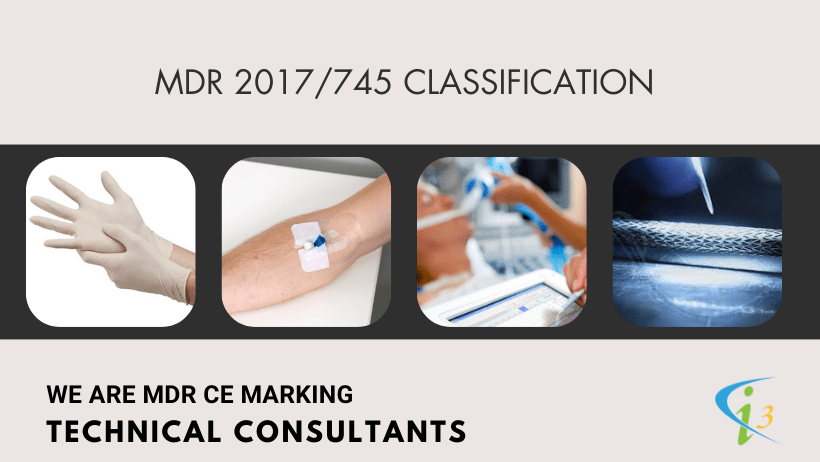Quick Contact

MDR Medical Device Classification
According to article 51 of the new Medical device regulation, the medical devices are categorised into classes I, IIa, IIb, and III, considering their intended purposes and their inherent risks. The risk is incremental from class 1 to class III. The MDD and MDR both use a rule-based medical device classification pattern. In the new MDR, there are now 22 rules in Annex VIII. The determination of the EU MDR medical device classification and the corresponding rule is the first step in the EU CE marking process. Based on the class and the rule of the device, the technical file and the Notified Body application can be filed.
MDR Classification and Body placement
- Non-invasive devices work outside the body generally pose lower risks and fall under Class I or Class IIa
- Invasive devices pierce or enter the body through an opening or its surface. Due to this they are considered higher risks and fall under Class IIb or Class III
- Active devices rely on an external power source like electricity, batteries, or chemicals to function generally falls in Class IIb or Class III
MDR Classification and Duration of use
- Transient devices are intended for continuous use for less than 60 minutes.
- Short-term use devices are intended for continuous use between 60 minutes and 30 days
- Long-term use devices are intended for continuous use for more than 30 days.
Interested to know more about the classification of medical devices and our CE Marking services in 2 minutes?
Medical Device Classification with Examples
Class 1 - Low Risk
- Examples: corrective glasses and frames; manual wheelchairs
- Type of Certification: Self-Certification or Self-Declaration
Class 1s Low Risk (Sterile)
- Examples: personal protection kits, sterile urine bags, etc.
- Type of Certification: Notified Body
Class 1m Low Risk (Measuring Body attributes)
- Examples: stethoscopes, weighing balance
- Type of Certification: Notified Body
Class 1r Low Risk ( Reused Device)
- Examples: Surgical forceps (all types of SS/TIT surgical equipment sterilized and reused by hospitals)
- Type of Certification: Notified Body
Class IIa - Medium Risk
- Examples: orthodontic wires, surgical gloves, lancets
- Type of Certification: Notified Body
Class IIb - Medium to High Risk
- Examples: orthopedic nails and plates; intra-ocular lenses; incubators for babies
- Type of Certification: Notified Body
Class III - High Risk
- Examples: pacemakers, prosthetic heart valves, cardiovascular sutures, brain spatulas, drug-device combination products
- Type of Certification: Notified Body
Rules of Medical Devices Classification
As per Annex VIII of the EU Medical Device Classification Rules, they are as follows:
- Rules 1–4: Non-invasive devices are generally considered Class I medical devices. However, Class IIa, Class IIb, and Class III medical devices can also be used for non-invasive devices
- Rules 5–8: Invasive Devices are mostly considered Class IIa, Class IIb, and Class III medical devices. Still, some devices categorized under these rules are classified as Class I
- Rules 9–13: Active devices can pertain to Class I, Class IIa, Class IIb, and Class III, depending on body placement and duration of use
- Rules 14–22: Special Rules
What is special in MDR Classification?
EU Regulation 745/2017, annexe XVI included a list of beauty devices as medical devices. They are the following
- Different kinds of lenses, which include the so-called fun lenses, nonprescription coloured contact lenses
- Implants without a medical function such as breast implants for a cosmetic purpose( with medical devices were covered previously)
- Cosmetic fillers are used to inject into lips to plump up and reduce wrinkles in the face
- Devices and instruments used for liposuction, lipolysis, and lipoplasty
- Light-emitting devices such as lasers or intense pulse light (IPL) devices for hair or tattoo removal, skin treatment and resurfacing
- Brain stimulation devices to stimulate or influence moods
I3CGLOBAL completed 300+ CE certifications worldwide by supporting manufacturers with EU medical device classification of simple and complex device technologies for faster-notified body approval. We have offices in India, Europe, and the USA to help with classification and technical documentation.
Frequently Asked Questions
What are Special Rules?
Special rules cover devices incorporating medicinal products, devices manufactured utilizing tissues or cells, and devices for contraception or prevention of the transmission of sexually transmitted diseases. These rules falls in 14 to 22 and occupationally classified as Class IIa, Class IIb, or Class III
What are the new class included in EU 2017/745?
The new medical device classification included the reusable surgical instruments category, which applies to all surgical instruments sold by manufacturers in non-sterile conditions and sterilized by hospitals post-usage. These are multi-use devices.
